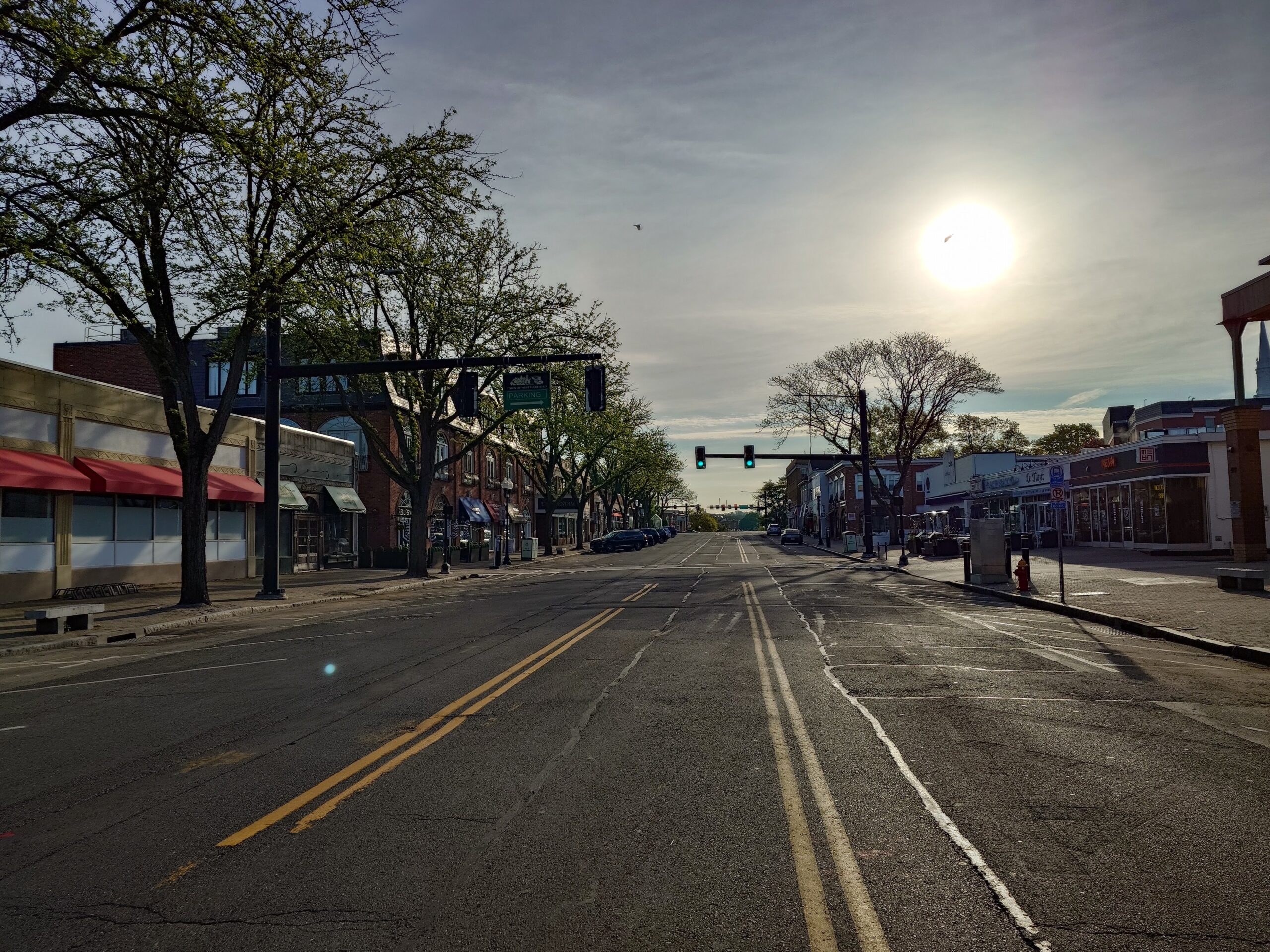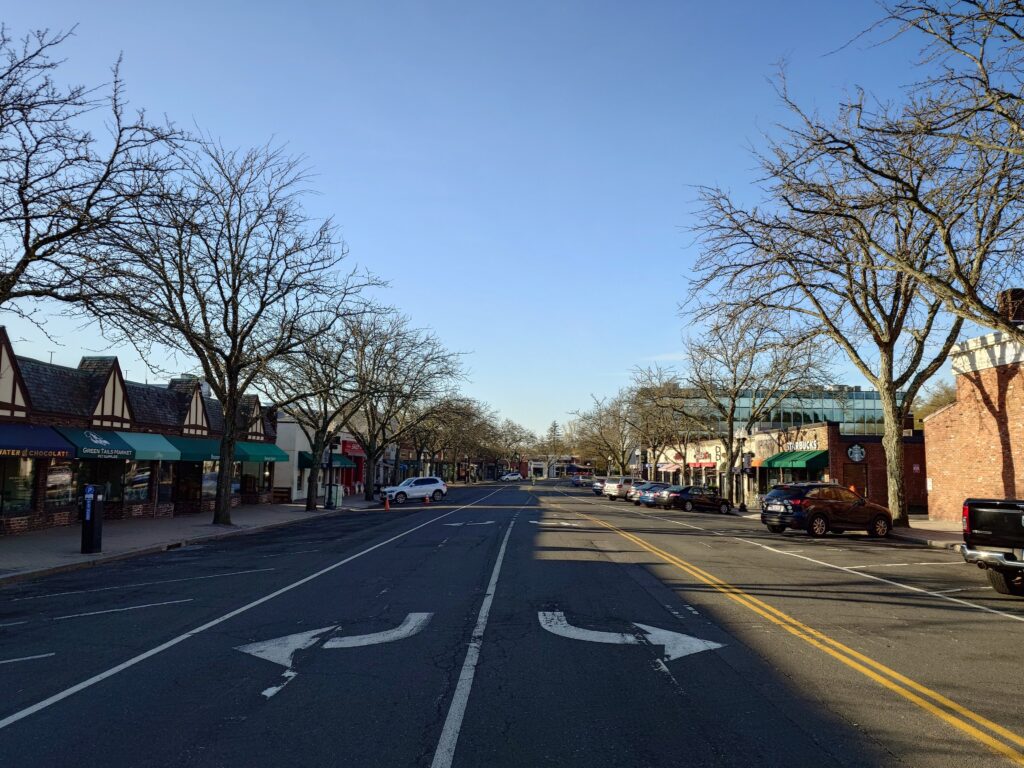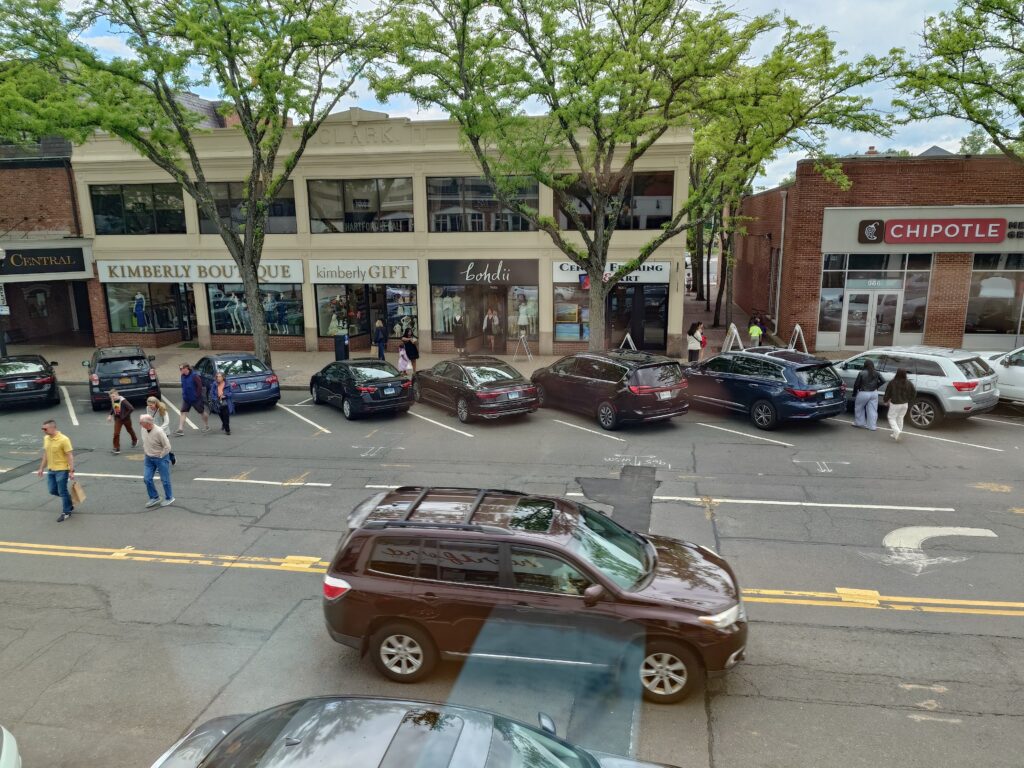Op-Ed: Re-Imagining Our Town Center Begins With Re-Imagining Parking

Audio By Carbonatix

This is the amount of roadway we have to work with on Farmington Avenue. Photo credit: Jason Wang
West Hartford resident Jason Wang has done some research on his own, and suggests ways in which parking should be re-imagined to create to have the best possible West Hartford Center for now and into the future.
By Jason Wang
Over the last two years, we have had the wonderful opportunity to re-imagine West Hartford Center for the next generation. A vigorous, healthy civic debate is taking place about the best way to use our valuable public streetscape, and a great deal of that debate has come down to how we can best support our local businesses – especially retail stores, which are understandably anxious due to macroeconomic e-commerce trends.
After extensive study, including groundbreaking data about the surprisingly low utilization of our existing parking resources, Stantec recommended a visionary plan to widen our sidewalks, calm traffic, add bicycle lanes, and propel our town center into the future. The Stantec plan, currently known as “Plan A,” would increase safety and improve the experience for all visitors to our lovely town center. It would reduce greenhouse gas emissions, congestion, and localized air pollution by reducing vehicle miles traveled. It would be a model for surrounding towns, many of which are also working to redesign their own town centers for the future.
In the process of developing “Plan A” throughout 2022-23, the town solicited extensive input from all stakeholders including businesses. However, late last year several business owners became publicly concerned about the potential effect on their operations – namely due to the transition from diagonal to parallel parking, as well as the extent of construction disruption. These are totally understandable, reasonable concerns. Parking especially tends to elicit strong emotions, including sometimes fear and frustration.
Enter the “hybrid plan” introduced in April 2024, which is not much of a hybrid, and more of a wholesale retreat from all innovative and progressive change. The hybrid plan was mostly created out of fears about parking. However, I think we need to have a little more empiricism and a little more thoughtfulness as we approach our parking challenges. After all, street parking, particularly the diagonal variety, consumes an absolutely huge amount of our extraordinarily valuable public land. We need to step back and get some real data: will slightly reducing street parking in exchange for significantly improved pedestrian and bicycle amenities actually harm our local businesses?

And this is the amount of roadway we have to work with on LaSalle. Photo credit: Jason Wang
First, we need to get a few facts out of the way. Stantec provided our town with incredibly valuable information about the overall utilization of our parking. They found that we have over 5,000 spaces between the Center and Blue Back Square, which are nowhere near full even during peak hours. So there is no parking shortage. At all. In fact, if we learned nothing else from our hundreds of thousands of dollars in consulting fees, it would be worth it just to know that we never, ever should build another multimillion dollar garage. We just need to use our existing space better.
Second, we know from common sense and our own eyeballs that retail business operating hours and peak parking hours do not overlap for the most part. During the weekdays at typical retail hours (approximately 10 a.m. to 5 p.m.) there tends to be plenty of street parking available. Peak parking demand tends to be on weekends, especially weekend evenings when restaurants are in full swing. Weekend daytime is the only period when retail businesses and peak demand tend to coincide, and some retail businesses do not even open on Sundays.
So do retail businesses rely on storefront street parking space for their survival? Will even a modest reduction in street parking somehow lead to a retail apocalypse? I decided this is actually an easy question to answer empirically.
On the afternoon of May 11, a breezy but sunny Saturday, my family and I biked into town, joined some good friends for lunch at Bar Taco (sorry, bartaco) followed by coffee at Hartford Baking Co., and embarked on a simple study. We recorded the activity of the retail cluster consisting of Kimberly Boutique, Kimberly Gift, Bohdii, and Center Framing and Art between the hours of 1 and 3 p.m. We measured the following:
- How many people parked in the 7 spaces directly in front of those stores and walked in to shop?
- How many people walked into the stores from elsewhere?
- How many times did any of the 7 storefront parking spaces turn over?
- When a car did leave a parking space, how many were refilled by a new car within 1 minute or less?

The study area. Note the number of pedestrians crossing mid-block. Note the lack of a new mid-block crosswalk in either of the Stantec plans. Photo credit: Jason Wang
We reasoned that if the town is going to renege on Plan A due to concerns that street parking reduction might somehow ruin small businesses, we need hard evidence about how dependent these businesses truly are on street parking. Here’s what we found:
- During those 2 hours, 0 people parked in any of the 7 storefront spaces and walked in. Again, the stores received ZERO potential customers from storefront street parking. Z-E-R-O.
- On the other hand, 153 people walked in from locations farther away. Many emerged with purchases!
- The 7 storefront street parking spaces turned over only 13 times in 2 hours.
- Of the 13 parking turnovers, 12 refilled in 1 minute or less. In many cases, cars held up traffic on Farmington Avenue for several minutes waiting for the previous driver to clear the space, so the actual turnover time of the parking space (from one car leaving to the next car arriving) was effectively just a few seconds.
This little study shows that retail in West Hartford is far more dependent on foot traffic than on the absolutely highest convenience of parking. The lack of parking turnover suggests that even dramatically expanding street parking spaces would hardly increase the number of potential customers in comparison to foot traffic. Conversely, transitioning to much safer and more space-efficient parallel parking would barely decrease the customer pool. If 7 diagonal spaces barely turn over, then 4 or 5 parallel spaces would also … barely turn over. The very rapid refilling of emptied spaces suggests that demand for street parking space is too high, hence the misperception that there is an overall parking shortage.
Our study may be small and informal, but reflects an enormous body of studies across the world that all show the same thing: business owners tend to overprioritize street parking spaces and overestimate how much of their income is dependent on ultra-convenient street parking. There is also extensive data from trailblazing cities and towns showing that by building more pedestrian-, cyclist-, and basically human-friendly downtowns, we can dramatically improve business prosperity. In New York, for example, redesigning 9th Ave to be more pedestrian and cyclist friendly caused business revenues to increase by 49%, compared to business revenues in surrounding areas which only increased by 3% in the same timeframe, while injuries for all street users dropped by 59%.
Finally, there is excellent research showing that people who arrive to businesses by walking or bicycle spend slightly less per trip than those who arrive by car, but actually spend more total money over the course of time – five times more, to be precise, according to a 2011 Transport for London study. I think deep down the business owners know all of this. After all, why did Hartford Baking Co. move from their old location on New Park Ave with its delectably easy parking? Why do businesses choose to pay much higher rent to be in the Center, rather than being in a strip mall with all the parking their hearts desire?
Here’s why: businesses in West Hartford Center thrive not because of ultra-convenient parking, but because West Hartford Center is a vibrant walkable destination. There is no economic justification for preserving or expanding street parking to “save” business. These stores do not rely on ultra-convenient storefront street parking for success – they rely on foot traffic.

A strip mall, built for cars instead of humans. Notice that it is not thriving. But it’s easy to park! Photo credit: Jason Want
That brings me back to our debate on how to redesign the Center. We would be publicly kicking ourselves in the collective economic nards if we decide to renege on Plan A and give up on all the wonderful pedestrian/bicycle amenities, in exchange for a few crappy parking spots that, at peak parking demand, don’t turn over anyway! It would be a bargain with the devil, except this is a terrible analogy because in this case the devil is nobody in particular (Big Asphalt?), and we aren’t even getting anything cool in exchange – just extra congestion, extra pollution, extra greenhouse gases, less outdoor dining, less safety, and less foot traffic. We would be giving up a huge amount of extraordinarily valuable public right-of-way in exchange for no benefit to local businesses.
We need to build the Center for humans first, not cars. That means keeping ALL of our expanded outdoor dining, calming traffic, improving and increasing pedestrian crossings, increasing greenery, increasing street furniture, adding pocket parks, and adding safe bicycle facilities.
We have a huge surplus of parking but it is misallocated, and that disfigures our land use! Street parking needs to be priced to reflect its value. At non-peak times, which is when retail businesses are typically open, parking could very well be cheaper. There may not be enough demand to support the current $1.75 per hour pricing at non-peak times. But at peak hours, such as Friday evenings and weekends, the price probably needs to be something closer to $4 per hour to generate the turnover and availability critical to building a thriving downtown.
Do businesses really care exactly how many street parking spaces there are? I suspect they actually just care that their customers can find a space when they want it. It’s about parking availability – not sheer quantity – and availability is dictated by pricing. This is not a money grab. By addressing the market dynamics of parking, the average price paid may not even increase, while we would banish the misperception of a street parking shortage, kill any temptation to ever build another multimillion dollar garage, and refocus ourselves on using the public right-of-way for the maximal public benefit – with the happy effect of probably increasing business revenues as well. (I would also like to pre-empt any bad faith arguments tokenizing the physically disabled: market-priced street parking creates more availability of parking spaces, in which those with ADA placards can park for free per town regulations.)
While our parking study combined with the existing body of research strongly refutes the idea that businesses depend on storefront street parking for their economic survival, it reinforces the concern that construction disruption could very well cause real harm to foot traffic, the actual source of revenues. Town engineers need to make every effort possible to avoid construction disruption, such as building at night and staging construction in small increments. That is a principle that we should all rally behind. We must not make construction overly unpleasant or overly slow, and we need to support our local businesses through construction knowing that they will likely be even more prosperous on the other side.
As many have pointed out, our town center probably won’t be redesigned again for many more decades. We need to build a West Hartford Center that is progressive, smart, beautiful, safe, and environmentally friendly. That really comes down to the sometimes mundane, but occasionally impassioned issue of parking. Parking eats up a huge portion of our public right-of-way, and if we mess up on parking, if we treat parking based on fear and feelings rather than empiric data, we mess up our town redesign for the next generation.
West Hartford Center is the engine of our growth and prosperity. It’s core to our town identity. We should muster up all of our leadership and vision, and maybe a tiny bit of courage, to build the best possible Center for the future.
We-Ha.com will accept Op-Ed submissions from members of the community. We reserve the right to edit all submitted content.
Like what you see here? Click here to subscribe to We-Ha’s newsletter so you’ll always be in the know about what’s happening in West Hartford! Click the blue button below to become a supporter of We-Ha.com and our efforts to continue producing quality journalism.




Thanks Jason for this work – the research, the observations and tying it all together. I hope the town will use this information to change their decision, thinking more about foot traffic than auto traffic.
The above points are all well-made. The hybrid plan is an abandonment of securing West Hartford’s future and aligning to the the true development needs of the center in favor of a few unnecessary parking spaces. There are entire sections of city centers that are pedestrian zones, and no surprise, still have robust dining and retail storefronts. Privileging parking over what really makes a town thrive and become both a destination and a more enjoyable, pleasant, and safer space to live would be a major mistake that would set West Hartford backwards for decades.
These are great points and consistent with academic research showing that removing parking to create bike lanes has positive or null effects on business revenue. Given the glut of available parking in the center garage, we should work to make the center more welcoming to pedestrians and cyclists and create more space for outdoor dining, shopping, and socializing. This would bring more people to the center and enhance business revenue. Let’s rely on the evidence in these important decisions rather than unfounded fears:
https://www.tandfonline.com/doi/full/10.1080/01441647.2021.1912849
https://www.tandfonline.com/doi/full/10.1080/01944363.2019.1638816
https://www.sciencedirect.com/science/article/abs/pii/S0966692323002053?via%3Dihub
I am 100% here for any discussion that includes the phrase “kicking ourselves in the collective economic nards.” Very well said Jason! And holy crap – 5,000 parking spaces??? 5,000??!?!? I think we can stand to lose a few to make a more walkable and bikeable Center.
Here are a couple of thoughts to add to the general parking discussion- #1- Parking is simply the storage of private property on the public right-of-way. #2- By conservative estimate, there are three parking spots for every car in this country. #2- An individual parking space costs roughly $5,000 to build.
Here in West Hartford, we are falling behind on road maintenance because of the cost while those in charge will tell you that we’re in “incredible” financial shape. The additional residential development, added to increase tax revenue, will wear out our roads even faster due to the lack of good public transportation. Don’t we need to do everything that we can to encourage people to walk and ride in West Hartford, even if it’s merely for our town’s economic survival?